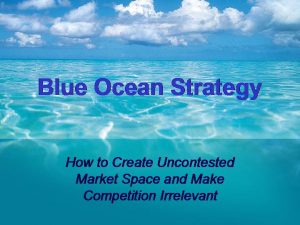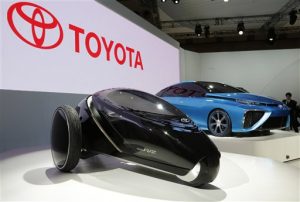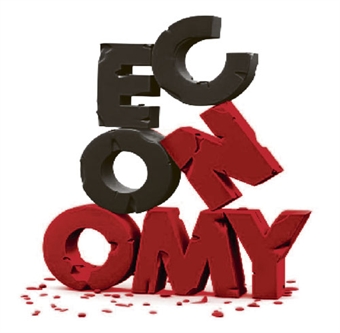 The Blue Ocean Strategy coined by W. Chan Kim and Renée Mauborgne recognizes that that there is no such thing as permanently great company, nor a permanently great industry. But there are permanently great strategic moves. Blue Ocean Strategy is the result of a decade-long study of 150 strategic moves spanning more than 30 industries over 100 years (1880-2000). The three key conceptual building blocks of Blue Ocean Strategy are: value innovation, tipping point leadership, and fair processes. In the globalized markets we have been witnessing the technologies getting obsolete within short span of time; we have witnessed productivity falling within short intervals, supplies exceeding demands, products living short life cycles, uncontrolled substitution, and new entrants on prowl. The globalization process has added a component that facilitates new entrants. Thus Blue Ocean Strategy discusses importance of innovation in every business process.
The Blue Ocean Strategy coined by W. Chan Kim and Renée Mauborgne recognizes that that there is no such thing as permanently great company, nor a permanently great industry. But there are permanently great strategic moves. Blue Ocean Strategy is the result of a decade-long study of 150 strategic moves spanning more than 30 industries over 100 years (1880-2000). The three key conceptual building blocks of Blue Ocean Strategy are: value innovation, tipping point leadership, and fair processes. In the globalized markets we have been witnessing the technologies getting obsolete within short span of time; we have witnessed productivity falling within short intervals, supplies exceeding demands, products living short life cycles, uncontrolled substitution, and new entrants on prowl. The globalization process has added a component that facilitates new entrants. Thus Blue Ocean Strategy discusses importance of innovation in every business process.
The form of strategizing within a specific economic structure, dictated by demand and availability of resources, is termed as Red Ocean Strategy. Red Ocean represents all of the existing industries in a market place. Firms compete very hard for market share; they fight so tough that the market gets bloodier; hence the term Red Ocean Strategy. While avoiding use of Mr. Michael Porter’s name, Mr. Kim and Ms. Mauborgne nevertheless attack him head on, arguing that the “five forces” analysis is a formula for remaining in “red oceans,” where the business sharks (market leaders) compete ruthlessly for the action. The key to exceptional business success, they say, is to redefine the terms of competition and move into the “blue ocean,” where you have the water to yourself. The goal of these strategies is not to beat the competition, but to make the competition irrelevant.
Though the Red and Blue Ocean Strategies seem offer two different approaches of looking at strategizing, they are much interconnected and would continuously feed each other. If the markets don’t get overcrowded and if there are no market warfare entrepreneurs will not get out of those markets. I think it’s the Red Ocean which drives out entrepreneurs to create new products and services and profitable businesses models. At the same time, new ventures, which directly contribute to the Blue Ocean, would draw the attention of investors that want to benefit from the tested and uncovered assumptions and hence would soon turn the blue into red.
 As more trawlers enter the Red Ocean, the harder it gets for them to be commercially viable, since the ocean does not get any bigger and the potential catch is shared out more. Customer demand remains the same but the number of suppliers continues to increase, thus encouraging fierce competitive practices to ensure that they get as much of the market out at sea, and also when they get back to port. Inevitably this means a price war – and blood everywhere, hence ‘Red’ Ocean. The pioneering company in the world Apple Computers Inc has tied to remain in Blue Ocean by innovating one after other products. While initiating their most out of the box product iPod used more than seven types of innovation. They included networking (a novel agreement among music companies to sell their songs online), business model (songs sold for a buck each online), and branding (how cool are those white ear buds and wires?).World over, people love the ease and feel of the iPod, but it is the simplicity of the iTunes software platform that turned a great MP3 player into a revenue-gushing phenomenon. Apple has guts, instead of fighting in the overcrowded music equipment market to get the bigger bite, the company touched heart of thousands of music lovers all over the world by introducing iPod.
As more trawlers enter the Red Ocean, the harder it gets for them to be commercially viable, since the ocean does not get any bigger and the potential catch is shared out more. Customer demand remains the same but the number of suppliers continues to increase, thus encouraging fierce competitive practices to ensure that they get as much of the market out at sea, and also when they get back to port. Inevitably this means a price war – and blood everywhere, hence ‘Red’ Ocean. The pioneering company in the world Apple Computers Inc has tied to remain in Blue Ocean by innovating one after other products. While initiating their most out of the box product iPod used more than seven types of innovation. They included networking (a novel agreement among music companies to sell their songs online), business model (songs sold for a buck each online), and branding (how cool are those white ear buds and wires?).World over, people love the ease and feel of the iPod, but it is the simplicity of the iTunes software platform that turned a great MP3 player into a revenue-gushing phenomenon. Apple has guts, instead of fighting in the overcrowded music equipment market to get the bigger bite, the company touched heart of thousands of music lovers all over the world by introducing iPod.
There is a most striking point about Blue Ocean Strategy – that is Blue Ocean has no memory, it has no reliance on any past trend of format. So to create new markets and develop focus on non-customers to create demand, blue ocean strategy is a fundamental approach. One key point of Blue Ocean Strategy is how to create value and how to make customer comfortable and willing to pay for it. Innovation has a key role on this matter, but, it must be aligned with utility, price and cost. Today, organizations across the world have understood that the key to their survival is innovation and creativity. Innovation does not mean only new products and services but it includes many more dimensions. It is about reinventing business processes and building entirely new markets that meet untapped customer needs. Most important, as the Internet has widened the pool of new ideas, it’s about selecting and executing the right ideas and bringing them to market in record time. In the 1990s, innovation was about technology and control of quality and cost. Today, it’s about business processes, efficiency and reworking for creativity and growth.
 Toyota Motor Corp., the Japanese auto giant is best known for their compulsive focus on innovations; be it manufacturing processes, new product development or a business strategy. Toyota is earning respect in all spheres of business as an innovator. It is collaborating closely with the customers and their suppliers to generate innovation. Two years back, Toyota launched its Value Innovation strategy for which the company involved its suppliers; instead of asking the suppliers just to cut costs of individual parts, Toyota spent both time and energy in exploring the design process with backward engineering for spanning entire vehicle system.
Toyota Motor Corp., the Japanese auto giant is best known for their compulsive focus on innovations; be it manufacturing processes, new product development or a business strategy. Toyota is earning respect in all spheres of business as an innovator. It is collaborating closely with the customers and their suppliers to generate innovation. Two years back, Toyota launched its Value Innovation strategy for which the company involved its suppliers; instead of asking the suppliers just to cut costs of individual parts, Toyota spent both time and energy in exploring the design process with backward engineering for spanning entire vehicle system.
Ginger is an Indian Hotels chain established by Roots Corp Ltd, part of Indian Hotels Company Ltd a subsidiary of Tata Group. Ginger Hotels has transformed its traditional in-house research and development process into an open-source innovation strategy. They call it “connect and develop.” Through this forum Tata Group has tapped lot of new innovators in the world and has used their innovations for betterment of the firm. It has encouraged many innovators, scientists, and suppliers for new products that otherwise could be developed in-house.
Hospitality segment, just like many other segments in India is booming at an unprecedented pace. India faces a huge challenge of being “under roomed” while the economy is growing rapidly. This provides for a huge opportunity for hospitality industry. A lot of large real estate developers are also investing into this business to bridge the demand-supply gap and leverage the opportunity. A number of cities have blossomed with suburban”Silicon Valley” type Special Economic Zones (SEZs). The middle class is becoming more prosperous and native Indian tourist travel is growing rapidly, particularly in places such as Goa, Kerala and Rajasthan. Tata’s Ginger Hotels is a smart move of the company to get into ‘Smart Basics’ concept hotels. Ginger has adopted guidelines and tips similar to Blue Ocean. It reflects the new emerging lifestyle in which people want to get things done quickly and efficiently.
 It has been ten years since the first Ginger hotel opened in Bangalore. The first prototype of no-frills hotel was launched in mid-2004 under the indiOne brand. In mid-2006, after fine-tuning the facilities and services based on customer feedback, the company re-launched the ‘Smart Basics’ hotels as the brand Ginger, a name designed to convey a stylish, warm and modern identity. It has been an exciting journey for the brand since then, with Ginger hotels now present in 20 locations across India. The plan is to have 70 operational locations with an average 100 rooms each by 2012 – 13. They have been able to successfully capture the imagination of budget business travelers with their value products. The company claims to be having around 65-70% average room occupancy with some properties fully booked for weeks in advance. Ginger has created a benchmark in the branded budget and economy hotel segment in India. The presence of Ginger across the country and the hotel’s need to increasing customer base has helped us understand the evolving needs of the customer, thus facilitating the process of regularly upgrading services for customers. For instance, despite being a no-frills hotel, it has now introduced limited room service allowing guests to order a select range of snacks.
It has been ten years since the first Ginger hotel opened in Bangalore. The first prototype of no-frills hotel was launched in mid-2004 under the indiOne brand. In mid-2006, after fine-tuning the facilities and services based on customer feedback, the company re-launched the ‘Smart Basics’ hotels as the brand Ginger, a name designed to convey a stylish, warm and modern identity. It has been an exciting journey for the brand since then, with Ginger hotels now present in 20 locations across India. The plan is to have 70 operational locations with an average 100 rooms each by 2012 – 13. They have been able to successfully capture the imagination of budget business travelers with their value products. The company claims to be having around 65-70% average room occupancy with some properties fully booked for weeks in advance. Ginger has created a benchmark in the branded budget and economy hotel segment in India. The presence of Ginger across the country and the hotel’s need to increasing customer base has helped us understand the evolving needs of the customer, thus facilitating the process of regularly upgrading services for customers. For instance, despite being a no-frills hotel, it has now introduced limited room service allowing guests to order a select range of snacks.
The innovation process, in the business framework, is a planned action that is remarkably easy to implement. It begins with a problem and ends with profit. As such, an ideal business process revolves around planned steps of processes. So it is remarkable that only few businesses have actually implemented this structured innovation process. Blue ocean strategy caters to spontaneous and unimaginable markets.
To help find the elusive “blue ocean,” Kim and Mauborgne argue that businesses and entrepreneurs must consider what they call the “Four Actions Framework.” According to the authors, the “Four Actions Framework” is used to reconstruct buyer value elements in crafting a new value curve. To break the trade-off between differentiation and low cost and to create a new value curve, the framework poses four key questions:
Raise: What factors should be raised well above the industry’s standard?
Eliminate: Which factors that the industry has long competed on should be eliminated?
Reduce: Which factors should be reduced well below the industry’s standard?
Create: Which factors should be created that the industry has never offered?
Under blue ocean strategy, however, the strategic challenges look very different. Recognizing that structure and market boundaries exist only in managers’ minds, practitioners who hold this view do not let existing market structures limit their thinking. To them, extra demand is out there, largely untapped. The crux of the problem is how to create it. This, in turn, requires a shift of attention from supply to demand, from a focus on competing to a focus on value innovation—that is, the creation of innovative value to unlock new demand. This is achieved via the concurrent chase of differentiation and low-cost. Under blue ocean strategy, there is hardly an attractive or unattractive industry per se because the level of industry attractiveness can be altered through companies’ conscientious efforts. As market structure is changed by breaking the value/cost tradeoff, so are the rules of the game. Competition in the old game is therefore rendered irrelevant. By expanding the demand side of the economy new wealth is created. Such a strategy therefore allows firms to largely play a non–zero-sum game, with high payoff possibilities.
 The Blue Ocean Strategy is well elucidated by Canada’s largest cultural exports, Cirque du Soleil, founded in 1984 by a group of street performers. Cirque has staged dozens of productions seen by some 40 million people in 90 cities around the world. In 20 years, Cirque has achieved revenues that Ringling Bros. and Barnum & Bailey—the world’s leading circus—took more than a century to attain. Cirque’s rapid growth occurred in an unlikely setting. The circus business as we all know is on decline. Alternative forms of entertainment such as sporting events, TV, and video games have conquered the circus business. Children, the main circus audience, preferred PlayStations to circus acts. There was also rising sentiment, fueled by animal rights groups, against the use of animals, traditionally an integral part of the circus.
The Blue Ocean Strategy is well elucidated by Canada’s largest cultural exports, Cirque du Soleil, founded in 1984 by a group of street performers. Cirque has staged dozens of productions seen by some 40 million people in 90 cities around the world. In 20 years, Cirque has achieved revenues that Ringling Bros. and Barnum & Bailey—the world’s leading circus—took more than a century to attain. Cirque’s rapid growth occurred in an unlikely setting. The circus business as we all know is on decline. Alternative forms of entertainment such as sporting events, TV, and video games have conquered the circus business. Children, the main circus audience, preferred PlayStations to circus acts. There was also rising sentiment, fueled by animal rights groups, against the use of animals, traditionally an integral part of the circus.
The champion performers of circus dictated their own terms. As a result, the industry was hit by progressively decreasing audiences and increasing costs. What’s more, any new entrant to this business gave a brash competition to the existing players.
How did Cirque profitably increase revenues in such an unattractive environment? Cirque reinvented the circus. Cirque did not make its money by competing within the confines of the existing industry or by stealing customers from existing players. Instead it created uncontested market space that made the competition irrelevant. It pulled in a whole new group of customers who were traditionally noncustomers of the industry; adults and corporate clients who had turned to theater, opera, or ballet and were, therefore, prepared to pay several times more than the price of a conventional circus ticket for an unprecedented entertainment experience. Today, Cirque provides high-quality artistic entertainment to the world.
A lot of research also reveals that large R&D budgets are not the key to creating new market space. The key is making the right strategic moves. In short, today’s world requires companies who can dare to do business differently, think differently and strategies differently.
Blue Ocean Strategy is indeed for bold corporations.













































